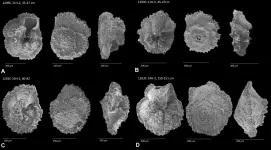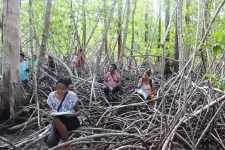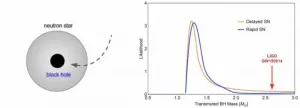(Press-News.org) Microscopic fossilized shells are helping geologists reconstruct Earth's climate during the Paleocene-Eocene Thermal Maximum (PETM), a period of abrupt global warming and ocean acidification that occurred 56 million years ago. Clues from these ancient shells can help scientists better predict future warming and ocean acidification driven by human-caused carbon dioxide emissions.
Led by Northwestern University, the researchers analyzed shells from foraminifera, an ocean-dwelling unicellular organism with an external shell made of calcium carbonate. After analyzing the calcium isotope composition of the fossils, the researchers concluded that massive volcanic activity injected large amounts of carbon dioxide into the Earth system, causing global warming and ocean acidification.
They also found that global warming and ocean acidification did not just passively affect foraminifera. The organisms also actively responded by reducing calcification rates when building their shells. As calcification slowed, the foraminifera consumed less alkalinity from seawater, which helped buffer increasing ocean acidity.
"The formation and dissolution of calcium carbonate help regulate the acidity and alkalinity of seawater," said Northwestern's Andrew Jacobson, a senior author of the study. "Our calcium isotope data indicate that reduced foraminiferal calcification worked to dampen ocean acidification before and across the PETM."
"This is a pretty new concept in the field," added Gabriella Kitch, the study's first author. "Previously, people thought that only the dissolution of carbonates at the sea floor could increase alkalinity of the ocean and buffer the effects of ocean acidification. But we are adding to existing studies that show decreased carbonate production has the same buffering effect."
The research was published online last week (March 4) in the journal Geology. This is the first study to examine the calcium isotope composition of foraminifera to reconstruct conditions before and across the PETM and the third recent Northwestern study to find that ocean acidification -- due to volcanic carbon dioxide emissions -- preceded major prehistoric environmental catastrophes, such as mass extinctions, oceanic anoxic events and periods of intense global warming.
Jacobson is a professor of Earth and planetary sciences at Northwestern's Weinberg College of Arts and Sciences. Kitch is a Ph.D. candidate and National Science Foundation Graduate Research Fellow in Jacobson's laboratory. Northwestern Earth science professors Bradley Sageman and Matthew Hurtgen, as well as collaborators from the University of California-Santa Cruz (UCSC) and the University of Kansas, coauthored the paper with Jacobson and Kitch.
Sorting microscopic shells
To study oceanic conditions during the PETM, the researchers examined the calcium isotope composition of foraminiferal fossils collected from two sites -- one in the southeast Atlantic Ocean and one in the Pacific Ocean -- by the Ocean Drilling Program.
Because each fossilized shell is about the size of a single grain of sand, UCSC researchers physically collected the tiny specimens by first identifying them under a microscope. After sorting the shells from bulk sediments, the Northwestern team dissolved the samples and analyzed their calcium isotope composition using a thermal ionization mass spectrometer.
"The work is very challenging," Jacobson said. "To manipulate these tiny materials, you have to pick them up, one by one, with a wet paintbrush tip under a microscope."
Stress prior to PETM
As the shells formed more than 56 million years ago, they responded to oceanic conditions. By examining these shells, the Northwestern team found that calcium isotope ratios increased prior to the onset of the PETM.
"We are looking at one group of organisms that built their shells in one part of the ocean, recording the seawater chemistry surrounding them," Kitch said. "We think the calcium isotope data reveal potential stress prior to the well-known boundary."
Other archives indicate that the atmosphere-ocean system experienced a massive carbon dioxide release immediately before the PETM. When atmospheric carbon dioxide dissolves in seawater, it forms a weak acid that can inhibit calcium carbonate formation. Although it is still undetermined, Earth scientists believe the carbon release most likely came from volcanic activity or cascading effects, such as a release of methane hydrates from the seafloor as a result of ocean warming.
"My suspicion is that it's both of these factors or some sort of combination," Sageman said. "Most big events in Earth's history represent a confluence of many actors coming together at the same time."
Consistent pattern emerges
This is the third study led by Jacobson to find that ocean acidification precedes major environmental catastrophes that correlate with large igneous province eruptions. Last month, Jacobson's team published results finding that volcanic activity triggered a biocalcification crisis prior to an ocean anoxic event that occurred 120 million years ago. Just over a year ago, Jacobson's team published another study finding ocean acidification preceded the asteroid impact leading to the Cretaceous-Paleogene mass extinction event 66 million years ago, which included the demise of dinosaurs.
In all three studies, Jacobson's team used sophisticated tools in his laboratory to analyze the calcium isotope composition of calcium carbonate fossils and sediment. Jacobson said a clear pattern is emerging. Influxes of carbon dioxide led to global warming and ocean acidification and, ultimately, to massive environmental changes.
"In all of our studies, we consistently see an increase in calcium isotope ratios before the onset of major events or extinction horizons," Jacobson said. "This seems to point to similar drivers and common responses."
"Perhaps the calcium isotope system has a sensitivity to the earliest phases of these events," Sageman added.
Predictor for future ocean stress
Many researchers study the PETM because it provides the best analog for current-day, human-caused global warming. The carbon influx during the PETM is similar to the amount of carbon released during the past two centuries. The timescales, however, differ significantly. Temperatures during the PETM increased by 5 to 8 degrees Celsius over 170,000 years. With human-caused climate change, the same level of warming is projected to occur in less than 200 years, if carbon dioxide emissions remain unabated.
Frighteningly, terrestrial and ocean stress, including a major decrease in foraminiferal calcification, accompanied the PETM.
"The PETM is a model for what happens during major large carbon cycle perturbations," Jacobson said. "A lot of predictions for Earth's future climate rely on understanding what happened during the PETM."
INFORMATION:
The study, "Calcium isotope composition of Morozovella over the Late Paleocene-early Eocene," was supported by a David and Lucile Packard Fellowship (award number 2007-31757) and the National Science Foundation (award numbers NSF-EAR 0723151 and DGE-1842165).
Artificial intelligence can already scan images of the eye to assess patients for diabetic retinopathy, a leading cause of vision loss, and to find evidence of strokes on brain CT scans. But what does the future hold for this emerging technology? How will it change how doctors diagnose disease, and how will it improve the care patients receive?
A team of doctors led by UVA Health's James H. Harrison Jr., MD, PhD, has given us a glimpse of tomorrow in a new article on the current state and future use of artificial intelligence (AI) in the field of pathology. Harrison and other members of the College of American Pathologists' Machine Learning ...
In a new paper published in Light: Science & Applications, the group led by Professor Andrea Fratalocchi from Primalight Laboratory of the Computer, Electrical and Mathematical Sciences and Engineering (CEMSE) Division, King Abdullah University of Science and Technology (KAUST), Saudi Arabia, introduced a new patented, scalable flat-optics technology manufactured with inexpensive semiconductors.
The KAUST-designed technology leverages on a previously unrecognized aspect of optical nanoresonators, which are demonstrated to possess a physical layer that is completely equivalent to a feed-forward deep neural network.
"What we have achieved," explains Fratalocchi, "is a technological process to cover ...
Women are largely being excluded from decisions about conservation and natural resources, with potentially detrimental effects on conservation efforts globally, according to research.
A University of Queensland and Nature Conservancy study reviewed a swathe of published conservation science, investigating the cause and impact of gender imbalance in the field.
UQ PhD candidate and Nature Conservancy Director of Conservation in Melanesia Robyn James said it was no secret that females were underrepresented in conservation science.
"In fact, according to a recent analysis of 1051 individual top?publishing authors in ecology, evolution and conservation research, only 11 per cent were women," Ms James said.
"We analysed more than 230 peer-reviewed articles attempting ...
One of the world's rarest tree species has been transformed into a sophisticated model that University of Queensland researchers say is the future of plant research.
"Macadamia jansenii is a critically endangered species of macadamia which was only described as a new species in 1991," said Robert Henry, Professor of Innovation at the Queensland Alliance for Agriculture and Food Innovation (QAAFI).
"It grows near Miriam Vale in Queensland and there are only around 100 known trees in existence."
However, with funding from Hort Innovation's Tree Genomics project, and UQ's Genome Innovation Hub Macadamia jansenii has now become the world's most sophisticated plant research model.
Professor Henry said ...
In a perfect world, what you see is what you get. If this were the case, the job of artificial intelligence systems would be refreshingly straightforward.
Take collision avoidance systems in self-driving cars. If visual input to on-board cameras could be trusted entirely, an AI system could directly map that input to an appropriate action -- steer right, steer left, or continue straight -- to avoid hitting a pedestrian that its cameras see in the road.
But what if there's a glitch in the cameras that slightly shifts an image by a few pixels? If the car blindly trusted so-called "adversarial inputs," it might take unnecessary and potentially dangerous action.
A new deep-learning algorithm developed by MIT researchers is designed to help machines ...
Cancers that are resistant to radiotherapy could be rendered susceptible through treatment with immunotherapy, a new study suggests.
Researchers believe that manipulating bowel cancers based on their 'immune landscape' could unlock new ways to treat resistant tumours.
Cancers can evolve resistance to radiotherapy just as they do with drugs.
The new study found that profiling the immune landscape of cancers before therapy could identify patients who are likely to respond to radiotherapy off the bat, and others who might benefit from priming of their tumour with immunotherapy.
Scientists at The Institute of Cancer Research, London, in collaboration with the University of Leeds and The Francis Crick ...
The public doesn't need to know how Artificial Intelligence works to trust it. They just need to know that someone with the necessary skillset is examining AI and has the authority to mete out sanctions if it causes or is likely to cause harm.
Dr Bran Knowles, a senior lecturer in data science at Lancaster University, says: "I'm certain that the public are incapable of determining the trustworthiness of individual AIs... but we don't need them to do this. It's not their responsibility to keep AI honest."
Dr Knowles presents (March 8) a research paper 'The Sanction of Authority: Promoting Public Trust in AI' at the ACM Conference on Fairness, Accountability and Transparency (ACM FAccT).
The ...
Lowering the operating temperature of solar panels by just a few degrees can dramatically increase the electricity they generate over their lifetime, KAUST researchers have shown. The hotter a panel gets, the lower its solar power conversion efficiency (PCE) and the faster it will degrade and fail. Finding ways to keep solar panels cool could significantly improve the return on investment of solar-power systems.
The long-standing focus of photovoltaics (PV) research has been to improve solar modules' PCE and make solar power more cost-competitive than nonrenewable power ...
What is the origin of black holes and how is that question connected with another mystery, the nature of dark matter? Dark matter comprises the majority of matter in the Universe, but its nature remains unknown.
Multiple gravitational wave detections of merging black holes have been identified within the last few years by the Laser Interferometer Gravitational-Wave Observatory (LIGO), commemorated with the 2017 physics Nobel Prize to Kip Thorne, Barry Barish, and Rainer Weiss. A definitive confirmation of the existence of black holes was celebrated with the 2020 physics Nobel Prize awarded to Andrea Ghez, Reinhard Genzel and ...
To effectively fight off SARS-CoV-2, the immune system depends on both antibodies and T cells, a type of white blood cell, which work together to eradicate the virus. However, little was known about virus-specific T cells in asymptomatic patients.
"We now know that many people are getting infected with SARS-CoV-2 without realising it, as they stay healthy and don't develop any symptoms. These asymptomatic infections may provide the key to understanding how the immune system can control the virus without triggering pathological processes," explained Dr Nina Le Bert, Senior Research Fellow ...




